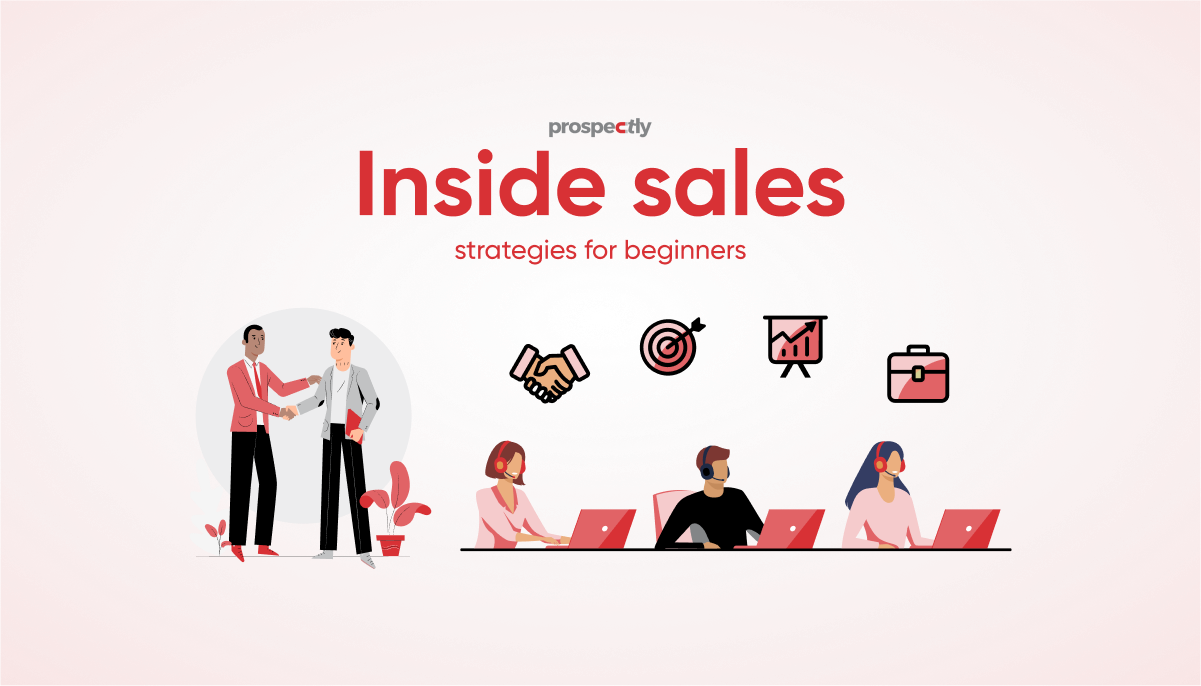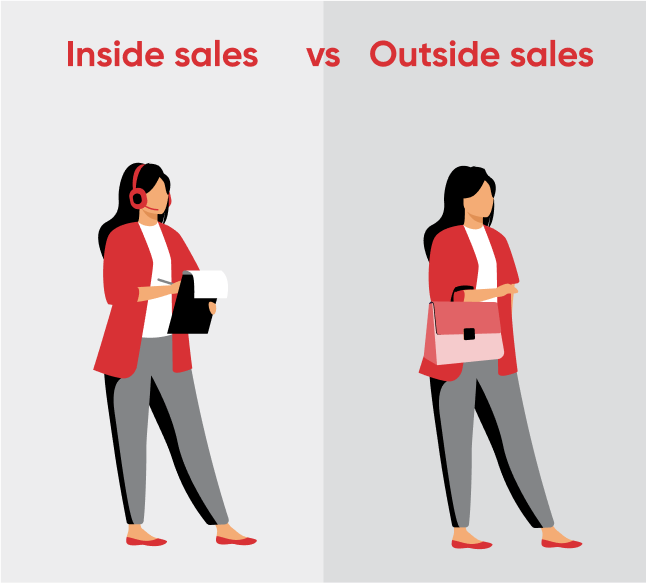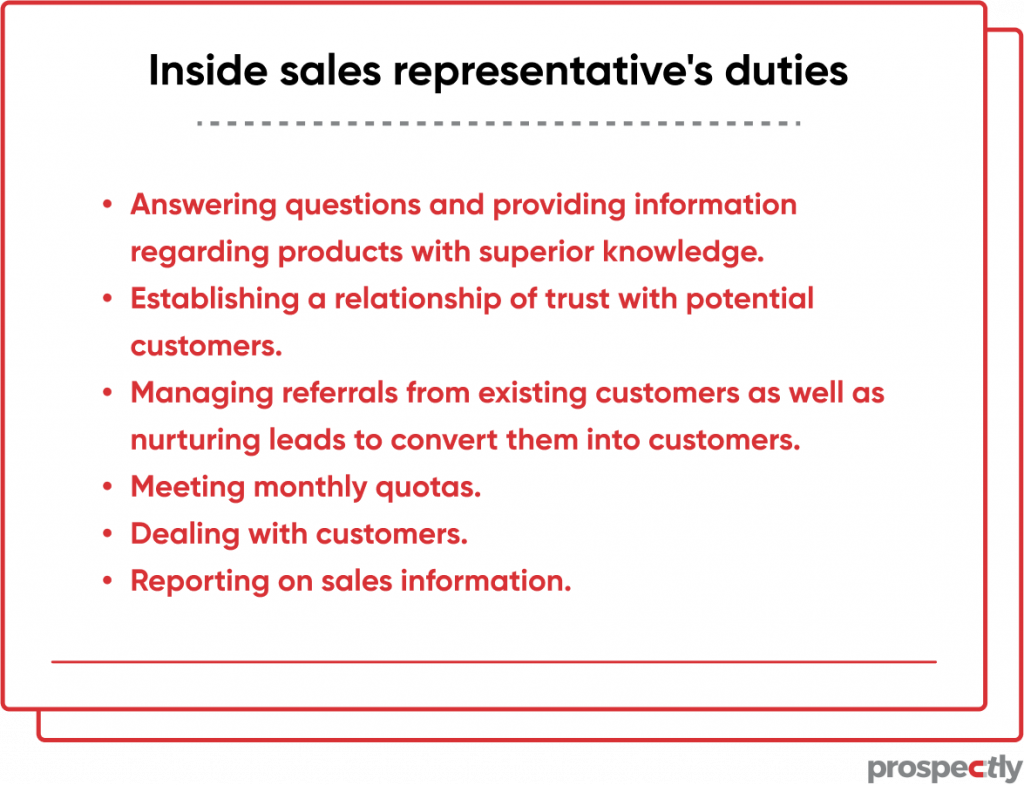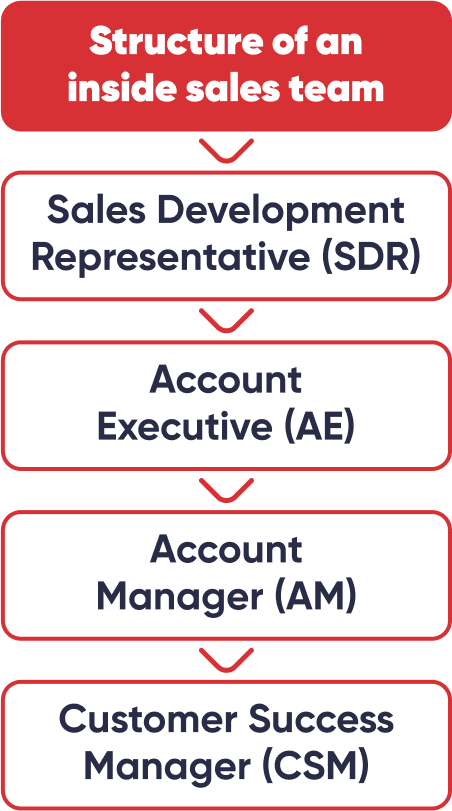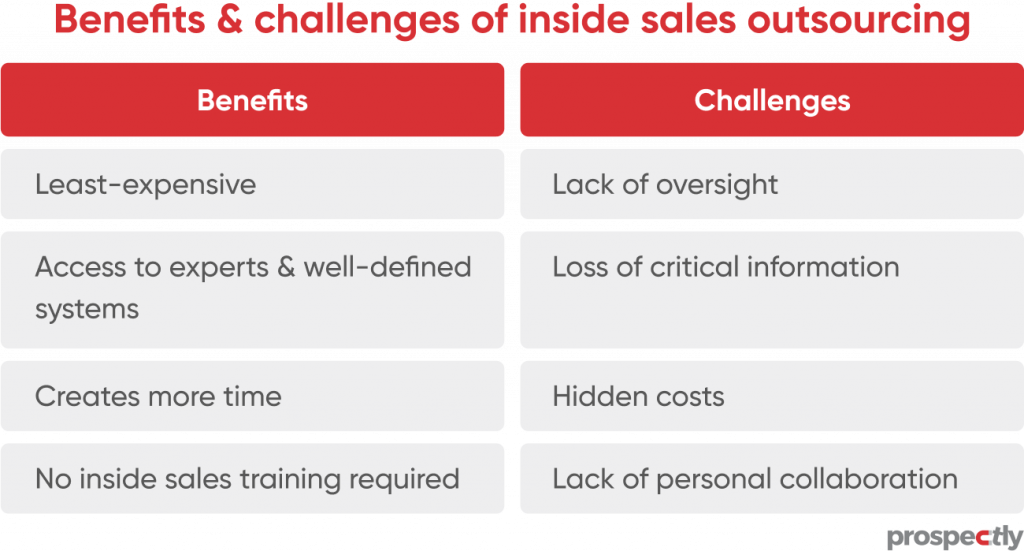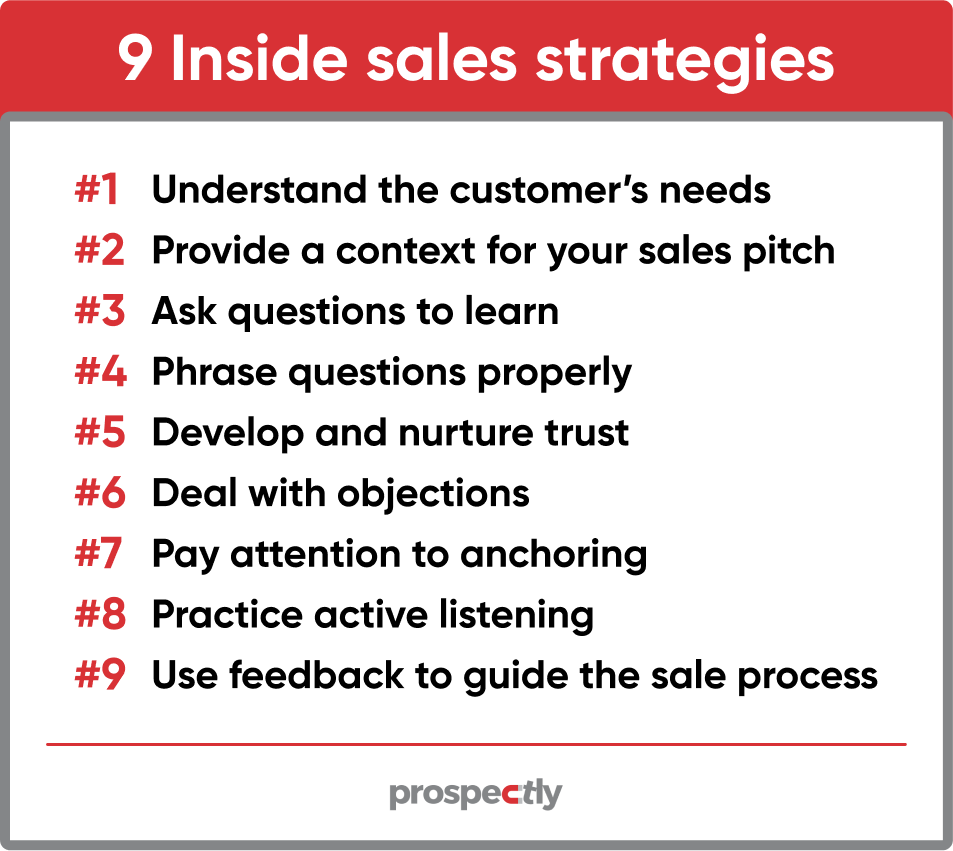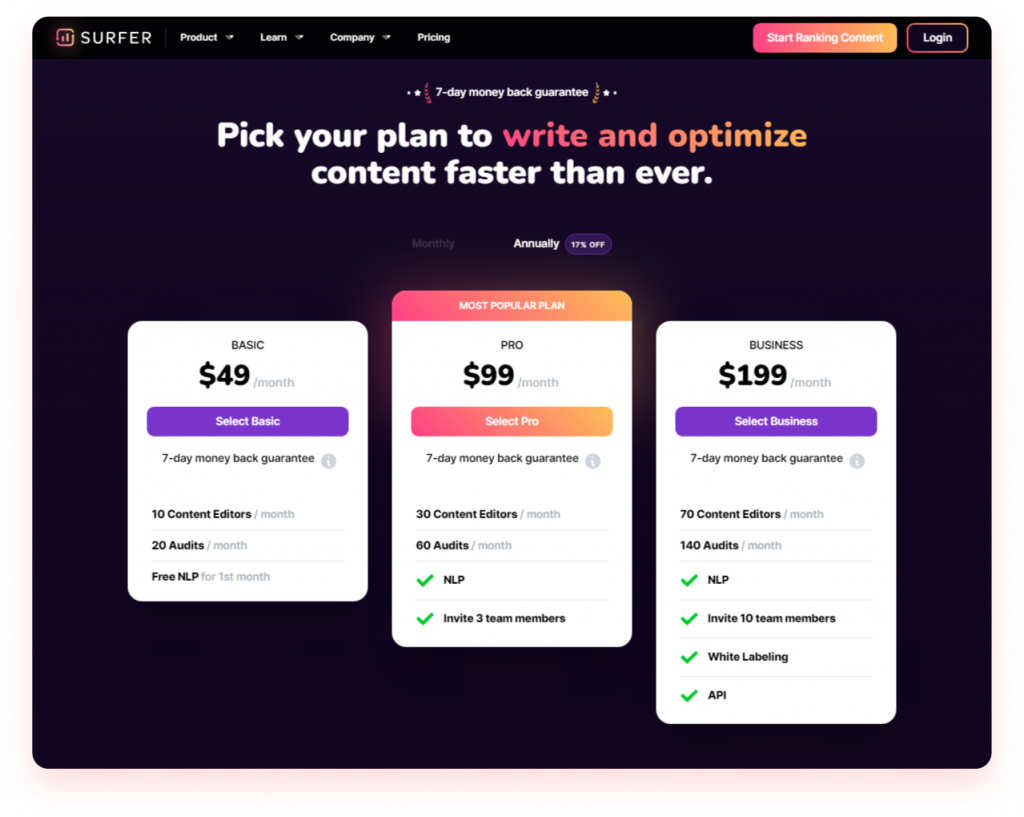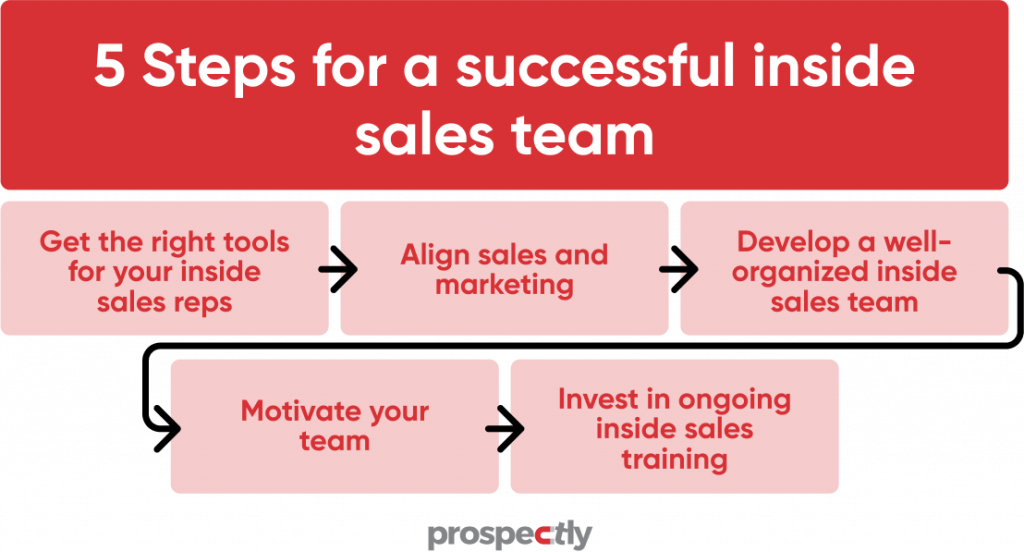On the surface, inside sales and outside sales seem to follow similar principles. Both need a motivated, driven salesperson that can interact with customers over the phone or by email.
However, there are some key differences between inside and outside sales. Understanding these distinctions can help you make better decisions that’ll benefit your business in the long term.
Read on to find out more…
What is inside sales?
Inside sales is selling a product or a service through digital means from the office or at home through an email or over the phone, etc. There’s no face-to-face interaction with the potential customer.
An inside sales rep uses multiple communication tools to engage with prospects, such as:
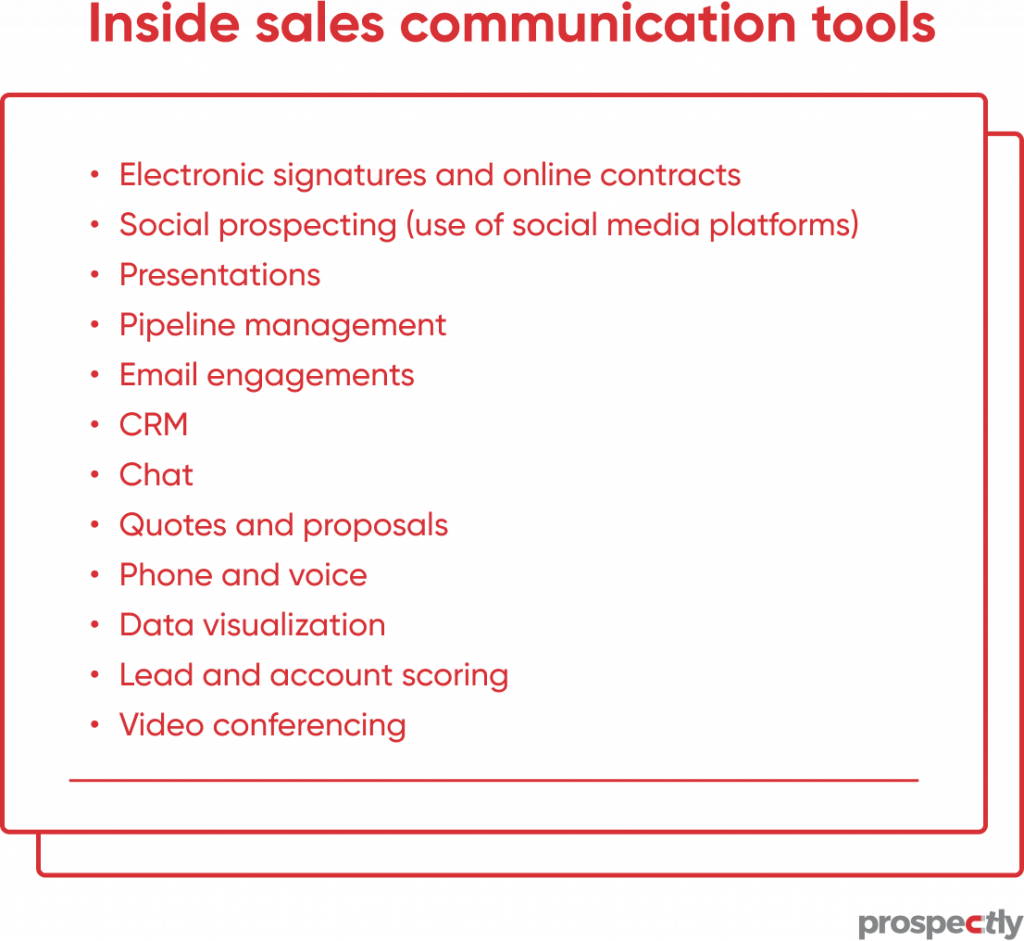
Several industries, like tech products, or SaaS use inside sales as their primary sales model. For example, you can explain prospecting software or any SaaS product via video conferencing.
Inside sales reps for SaaS products can use Zoom and other tech-savvy tools to prospect, close, and follow-up. SaaS clients can test drive the software by signing up for a free trial. Alternatively, they can watch a tutorial.
What is outside sales?
Outside sales is selling products or services in person. It’s also called field sales because the outside sales rep interacts with potential buyers at their offices or homes.
The sales model is primarily off-site as reps need to travel. A good example is a real estate agent who needs to view or show their buyers property for sale.
Such reps heavily rely on field trips to market their business.
However, they can also use email, social media, or the phone to schedule appointments. Outside sales reps can also attend industry events, trade shows, or conferences to meet up with prospective clients.
What are the key differences between inside sales and outside sales?
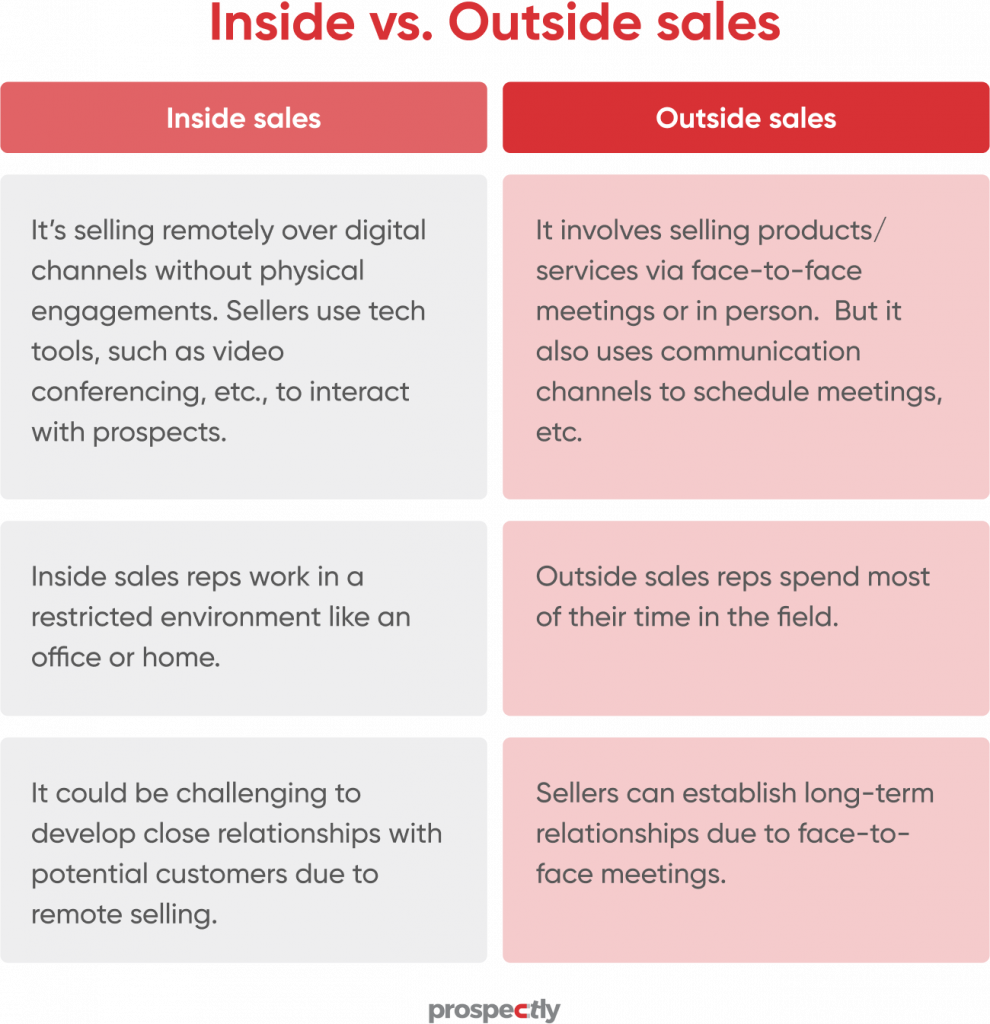
Specific industries seem to favor inside sales. As Zippia.com notes, “46% of fast-growing tech companies use inside sales and 21% use outside sales.”
Now, let’s explore the key responsibilities of inside and outside sales reps.
Inside sales and outside reps: What kind of work do they do?
Inside rep’s responsibilities
Inside sales reps work alongside sales teams. They handle everything from cold calling to emailing, building rapport with potential leads and scheduling online meetings.
Here are more tasks:
- They’re also responsible for generating new leads, qualifying them, and following up with them when they’re ready to buy.
- Inside sales reps manage the relationship between their company and the customer during the sale process.
- They also focus on generating revenue from existing customers and winning new business, as well as closing deals.
- Inside salespeople help improve the bottom line by growing the number of clients that they work with.
- As part of their responsibilities, they help manage client relationships and coordinate all account-related activities.
One of the biggest challenges is converting leads into sales. Inside sales reps need to learn how to engage with prospects to show value that’ll make them buy.
To achieve that, you need to zero in on the buyer’s pain points and know your product inside and out. And you should also empathize with your customers at every step of the process.
What are the inside sales rep’s vital skills?
Here are some of the skills your inside sales reps need to have. They must be able to:
- Build trust with prospects.
- Craft compelling sales pitches and remote presentations via video.
- Communicate product benefits clearly and confidently.
- Demonstrate empathy for customers’ needs and challenges.
- Create reports on sales data.
Bonus: An Amazon Inside Sales Representative is responsible for:
- “Exercising large account management and acquisition skills in a remote sales motion.
- Helping to grow consumption of current and new AWS services across priority prospects and customers.”
Outside sales rep’s activities
Field sales reps focus more on traveling to meet up with their potential buyers.
- They prospect, follow-up, and nurture customer relationships to close more deals.
- Outside reps visit conferences, industry events, and trade shows to scout for prospects, generate leads, or even sell their products.
- In addition, they can use CRM software, social media etc., to build and manage relations with their customers.
Zippia.com says outside sales reps sell remotely 89% more than they did in 2013. It shows that field sellers now use more digital tools than before.
What are the outside sales rep’s critical skills?
Selling face-to-face needs an individual who’s good at managing their schedules. You’re in charge of the whole sales process. Other relevant skills include:
- Time management
- Communication
- Interpersonal
- Digital
- Customer service
- Negotiation
How to structure your sales team: Inside sales vs. Outside sales
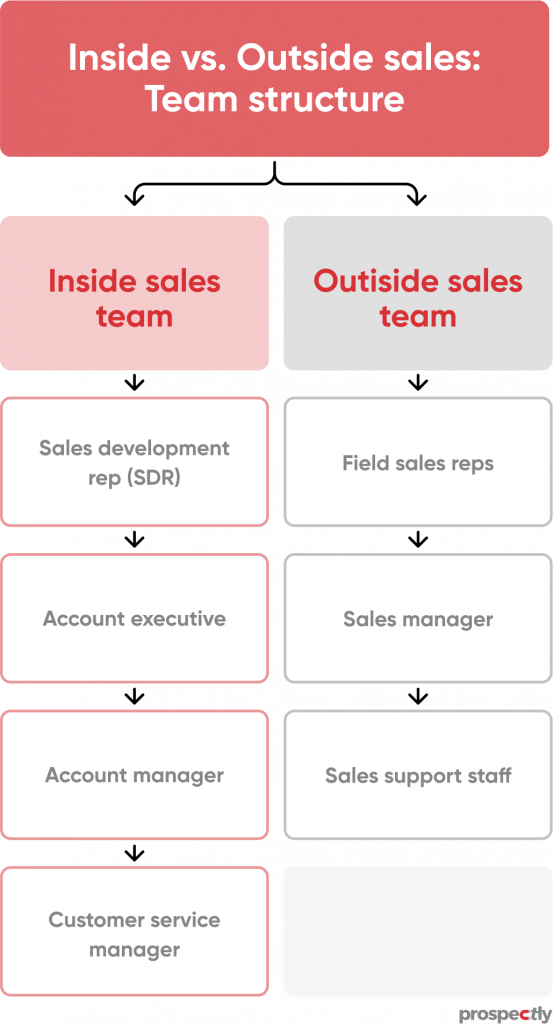
Let’s explore how you can organize your teams for each sales model.
Inside sales team
Typically, the inside sales team concentrates on lead gen, nurturing, and closing deals. Here’s the inside sales team structure:
Sales development rep (SDR): They generate, qualify, and even disqualify leads. Before they pursue prospects, SDRs need to determine if they fit their customer profile.
Account executive: They deal with the vetted or qualified leads to build rapport, warm the prospect, engage them, and make a sale.
Account manager: Working together with the account exec, they’re in charge of customer relationships. They ensure the company satisfies the buyer’s needs.
Customer service manager: They make sure the customer has a good experience with your product or service. And they respond to their questions, offer support, show buyers how to use your solution, etc.
Outside sales team
You can categorize outside sales reps according to territory, and the outside sales team could look like this:
Field sales reps: Outside sales reps travel to interact with their potential customers in person and attend events. Also, the prospect, close deals, and nurture customer relations. They develop robust relationships with buyers, unlike inside reps.
Sales manager: They’re in charge of supervising a group of outside salespeople in a specific territory. And they can attend demo meetings to support their reps. Also, they’re accountable to senior management on sales performance.
Sales support staff: They play a supportive role to the sales team. Some of their activities include managing orders, responding to customer queries, etc.
Inside sales vs. Outside sales: How to structure your quota attainment
Outside account executives achieve quota at a rate of 65%, 10% more than inside representatives – Zippia.com.
Your business growth hinges on your sales team crushing their goals. And you can achieve this by setting data-driven goals. For example, you can use past performance or industry benchmarks to create goals for your team to be realistic.
Also, you can rely on the overall business objectives to develop specific, measurable, and attainable inside sales goals. What’s your company’s monthly, quarterly, or yearly sales goal?
Based on that number, you can set a revenue goal for each inside sales rep. For example, an average inside salesperson has a quota of $985,000 – Zippia.com.
Establishing a quota for the outside salespeople could be challenging. That’s because sales territories have different deal sizes, etc. Some field sales reps could have higher targets in specific regions.
Zippia.com also says: “The average yearly quota for an outside sales rep is $2.7 million.”
Inside sales vs. Outside sales: What are the salary structures?
According to indeed.com, the average salary of an inside sales representative in the United States is $62,056 per year. And they could get $12000 as annual commission.
Salary.com reports that field sales reps earn an average salary of $61,032. But it can range between $52,228 and $70,570. It says factors, such as experience, education, skills, etc., can influence how much you get.
Another fascinating stat is that outside sales pros make an average of 14% more than inside sales pros.
Inside sales vs. Outside sales: Is the sales cycle different?
Selling products or services via inside sales has a shorter sales cycle compared to outside sales. While both approaches use the same sales process, an inside sales rep can conclude a sale within a few hours.
That’s because inside selling deals with less expensive products/services than field sales. Customers don’t take longer to decide to buy or subscribe to a service.
As a result, inside sales tends to focus more on volume to make up for the slim profit margin.
But outside sales take a longer sales cycle because buyers have to consider several factors, including cost. So the annual contract value (ACV) is higher.
Also, because of travel expenses, the customer acquisition value ( CAC) tends to be higher for outside salespeople.
For example, the cost of an outside sales call is $308, while the cost of an inside sales call is $50.
Typically, you can expect between 6 and 9 months to close a sale in outside sales if you’re dealing with enormous deals. Nearly three months or less could be enough to close a deal in inside sales.
However, the type of the customer, deal size, what you’re offering, etc., determine your sales cycle.
Pros of inside sales
Enhances teamwork: Inside sales reps can collaborate to win customers. For example, the SDR can specialize in qualifying or disqualifying prospects. The account executive can take over after the vetting process.
Outside sales heavily relies on a single individual to do everything from prospecting to closing deals.
Versatility: It’s easy to switch the roles or activities in inside sales because it doesn’t need territorial attachment. On the other hand, moving field sales from one region to another could be an issue for some salespeople.
They can develop personal relations with some customers. So adjusting their regions poses a challenge.
More selling time: Reps can concentrate more on prospecting and concluding deals because they don’t travel.
Slashes costs: Sending emails or conducting discovery calls is cheaper compared to meeting customers in person. “Inside sales teams pay 40%–90% less to acquire new customers.,”- Zippia.com
Lightning-fast response time: An inside sales rep can use digital methods to respond to customers faster. But an outside salesperson like a real estate agent needs to travel to view or showcase property.
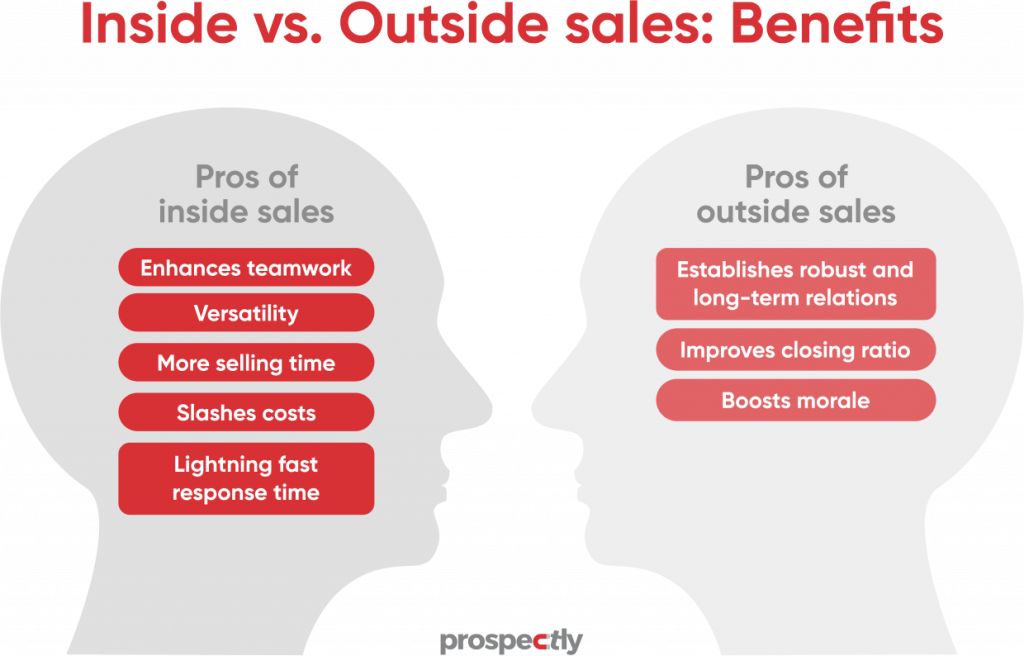
Pros of outside sales
Establishes robust and long-term relations: Face-to-face meetings with clients can develop win-win relationships. Reps can provide tailor-made solutions.
Improves closing ratio: Research says outside sales pros close 40% more deals than inside sales pros.It means this sales methodology is perfect if you’re dealing with gigantic deals that take a longer time to close.
Boosts morale: Field sales reps receive a commission in addition to their base salary. So a commission-based payment structure can motivate them to work harder to achieve their goals.
Inside sales vs. Outside sales: How are the sales models different?
Here’s what you should expect if you choose either inside sales or outside sales.
Inside sales model
Check out the following essential features of this sales approach:
- Reps use digital communication tools to engage with potential customers.
- It zeros in on lead gen and volume of sales.
- The sales method has a shorter sales cycle (less than 3 months).
- CAC is lower compared to field sales.
- Popular with SaaS and tech companies or businesses selling least expensive products or services.
Also read: Upgrade your virtual selling strategy with these 7 practical tips
Outside sales model
Here are the distinctive features of this sales method:
- It relies on face-to-face interactions as the reps have to travel to meet up with clients. But field reps also use digital channels.
- Rep is in control of the entire sales process.
- Its sales cycle is longer – over three months to close a deal.
- It’s most appropriate for premium products or services due to high CAC.
Over to you: How can inside sales and outside sales work together?
It’s easy to see why many companies employ inside sales reps. They can respond to customers faster over the phone or via email. So a swift lead response time wins more buyers and boosts sales.
Outside sales reps are more flexible to meet up with potential customers. That’s because they don’t have restrictions like mandatory hours or days off.
You can benefit from having a remote inside sales team and an outside sales team – a hybrid system. Both teams have different skills and target different types of buyers.
It’s crucial to remember that inside and outside sales reps need to engage their prospects with the right sales tools. And the type of business, products, customers, and your needs determine which sales model is perfect for you.
Also read: Inside sales strategies for beginners

